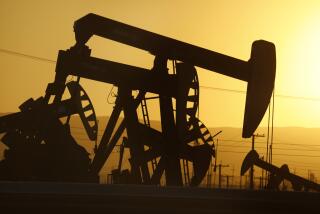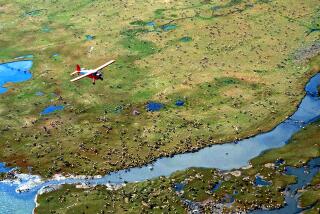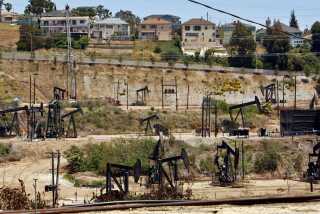Test Well in Arctic Wildlife Refuge Keeps Its Secrets
ARCTIC NATIONAL WILDLIFE REFUGE, Alaska â The hood of Karl Browerâs parka is trimmed with the nut-brown pelt of a wolverine. He trapped and skinned it. Its yellow claws cradle his chin and rattle in the bitter wind.
For 40 years, the Inupiat Eskimo hunter--caribou in the summer, bowhead whale in the fall--has chipped a scant living from this place, much closer to the North Pole than his nationâs capital.
Right now, Brower is pondering a question, squinting into the gloom that poses as high noon during the Arctic winter.
âItâs out there,â he mutters. He scans the same treeless, frozen frontier--The White--that some industrialists and politicians have scornfully compared to a blank sheet of paper, ripe for oil exploration. The âitâ he speaks of could be crucial to determining whether that exploration occurs.
âI worked it,â he says, recollecting the date. â19 . . . 1985.â
Brower straddles his snowmobile. He wedges a Marlboro into a jaw that once held several teeth. In minus-30-degree weather, he flicks his lighter with a bare thumb.
Can he still find it? Brower puffs for a moment.
âLetâs go,â he declares.
And without another word, Brower roars into The White in search of the biggest mystery in a 19-million-acre unknown--the Arctic National Wildlife Refuge.
Itâs an iron pipe, said to be sticking six feet out of the permafrost, the top of a 3-mile-deep shaft.
Or, more correctly, the mystery is what may be down the pipe. Way down.
The pipe marks the only oil well ever drilled into the bedrock beneath the refuge. Discovering how much oil is at the bottom could determine whether more drilling is permitted.
KIC-1, the test well is called.
It was drilled into the coastal plain southeast of Kaktovik, pop. 260, Browerâs hometown and the easternmost native village on Alaskaâs North Slope. The for-profit Kaktovik Inupiat Corp. owns land within the refuge. Sixteen years ago they leased it to Chevron and British Petroleum for a test bore.
Exploration geologists, aided by roustabout laborers like Brower, augered into the underlying sandstone.
On April 24, 1986, according to state court documents, they reached a depth of 15,193 feet at a cost of $40 million. Then they quit.
The oil companies capped the well and dismantled the wooden drilling platform. Eventually the tundra healed.
The companies wonât discuss what they found at the bottom of KIC-1.
Seawater?
Mud?
Gas?
Oil?
Ten years ago, Chevron won a lawsuit upholding KIC-1âs confidentiality. It remains a secret.
âOnly a handful of people know whatâs down the KIC well,â said BP Explorations spokesman Ronnie Chappell. âTheyâve never talked about it. Iâm not even sure who they are.â
Chappell continues: âIn January we flew low over the coastal plain, but we didnât bring the coordinates. We never did find the well that day.â
Passions Plentiful, Data Sparse
No single well can characterize an oil fieldâs potential, but thatâs no longer the point. KIC-1 has become the stuff of myth in a state that was born amid legends of gold, freedom and cold.
âKIC-1 is the only direct data from the subsurface of ANWR,â said Catherine Hanks, a research geologist at the University of Alaska-Fairbanks.
âThose companies have one more piece to the puzzle, a piece that nobody else has. Everybody else is guessing.â
Rarely has such a fundamental political battle been waged with so little information.
In January the National Academy of Sciences appointed a panel to investigate the impact of Alaskan oil and gas development. Its report isnât due for 18 months, which may be after Congress takes up permitting oil exploration here.
The rest of the scientific data--much of it nearly 20 years old--is as sparse as the tundra itself.
In 1984-85, a private seismic survey in a section of the coastal plain known as Area 1002 mapped a 1,400-mile grid that researchers crisscrossed in tracked vehicles. Working in six-mile squares, they fired explosive charges into the permafrost and measured the return of the seismic waves.
Different rocks produce unique acoustic signatures. Recorded in squiggly lines and graphs, the results were intriguing but not conclusive.
âWe did the whole thing from the bottom to the top,â said Anchorage geologist Arlen Ehm, who directed the survey.
It showed that the coastal plain is split diagonally by a steep underground ridge known as the Marsh Creek anticline. It runs from the foothills of the Brooks Range to the sea near Kaktovik.
New Calculations Hold Surprises
Three-quarters of the available oil was believed to be southeast of the anticline in a zone riddled with complex faults, folds and subterranean dead ends that split the oil-bearing layers into two dozen deposits, or âtraps.â
Most seemed small and difficult to tap, but two or three traps appeared to be Saudi-sized--big enough to hold billions of barrels of petroleum, although there is no direct proof that they contain any. The KIC-1 well is said to have been drilled into one of these.
Ehm believes the refuge is an oily place. Heâs seen it seep to the surface in small black pools.
âIt could produce for 25 years,â he predicts. âBut Iâm also a scientist. If it isnât there, you plug the wells and move on.â
By now, Ehm believed he would have earned his fortune selling the surveyâs details like a treasure map.
âI never thought Iâd be sitting here 20 years later still talking about what might be there,â he laments.
What about KIC-1?
Just rumors at the Petroleum Club bar, Ehm replies. âEverybody still wants to know.â
Without new studies, the U.S. Geological Survey began re-crunching the original seismic data in 1995 using more powerful computers and applying new theories about oil geology.
The results are startling. The USGS now believes that 85% of the refugeâs petroleum reserve exists northwest of the anticline, not southeast.
The agency estimates that between 3.4 billion and 10.2 billion barrels of oil are technically recoverable there.
Assuming an oil price of $20 per barrel--North Slope crude recently has been selling for $25--the USGS estimates there is a 95% chance that at least 3.2 billion barrels could be pumped profitably.
President Bushâs Energy Department has suggested the total refuge reserves could be even higher--16 billion barrels. And yet the president himself last month acknowledged for the first time that he may not be able to drill for it.
âI think itâs important for us to open up ANWR. Whether or not the Congress sees it that way is another matter,â Bush said at a news conference March 29.
Environmentalists contend the Arctic Refugeâs oil is a puny stash, not enough to satisfy the nationâs demand for a year.
Thatâs not a fair trade for spoiling the âbiological heartâ of the refuge, said Deborah L. Williams of the Alaska Conservation Foundation.
Williams, a former Interior Department advisor to President Clinton, cautiously endorses new coastal oil fields to the west, hoping to keep the refuge pristine.
âSome places should be kept as they were created,â she said. âIn 10,000 years, I hope the refuge looks as it did 10,000 years ago.â
KIC-1 is a dry hole, she believes. Oil companies, she suggests, perpetuate its mystery to whet the appetite of Congress and the public.
âI simply refuse to believe that if there is a huge amount of oil it could be kept secret,â she said.
Pressure on the refuge is mounting, even if information isnât. In late March, nearly 500 scientists signed a letter urging President Bush to protect the refugeâs 200 wildlife species and drop exploration plans.
Also last month, a USGS contract worker, Ian Thomas, was fired for posting a map on a government Web site of calving areas on the coastal plain for the enormous Porcupine caribou herd. Officials said the map was outdated.
In Alaska, where university research is partially funded by oil money, even wildlife biologists say they cannot afford to categorically oppose drilling.
âDrilling holds the potential to do great environmental harm to one of the worldâs last great undisturbed ecosystems,â said R. Terry Bowyer of the Institute of Arctic Biology. âItâs a very localized area every year that is suitable to calve, and the caribou have to reach it.
âBut,â Bowyer said, âis there a way to drill into the refuge horizontally? If they could come into it from the side, I think you would see a lot of the scientific objections disappear.â
Can both sides win? Can the refuge yield its oil silently, invisibly?
BPâs Chappell doesnât sugarcoat it. Oil production means huge drills chewing through the Earth. Slurries of mud and seawater are pumped down the hole at high pressure. Pipe and electrical transmission lines branch for hundreds of miles.
But todayâs oil production is neater, faster and cleaner than that of 20 years ago. Hundreds of wells cram onto a 40-acre gravel pad; they spread underground in all directions. Ice roads carry heavy equipment across the fragile tundra, then melt in summer.
Computers guide drills inch by inch for 7 miles through pipe as flexible as a hollow reed. Sensors measure naturally occurring gamma radiation signatures to learn whether the drill is hitting shale or oil-bearing rock.
One bit can thread its way to several deposits using the same bore.
Companies are testing magnetic resonance imaging tools similar to medical MRIs to âseeâ oil.
None of it is foolproof. âThe only way to find out is to drill,â Chappell said.
Peering Into the Past
Karl Brower finds it difficult to imagine the arrival of such technology in his backyard.
Off his snowmobile now, he stands on the tundra. The Inupiat hunter has found the KIC-1 well, 13 miles southeast of Kaktovik. He nailed it by memory in 30 minutes, skimming through The White.
Frost encrusts the pipe. Somebody crudely soldered the wellâs name and cap date on the iron. He traces the lumpy tattoo with his bare finger.
Someday this expanse could be punctured with 100 more wells.
Working at KIC-1 was one of the few times Brower has punched a time clock.
âI did it for the money,â he snorts.
Today, snowmobile fuel costs $3 per gallon. A pack of cigarettes costs $6. Round-trip air fare to Fairbanks: $700.
Brower leans against the pipe, staring into his own past and the refugeâs future--into The White, and into the Green.
Like everyone else in the refuge debate, Brower has more questions than answers.
Does he support more drilling? He shrugs.
âOnly if it doesnât hurt the caribou.â
BP has had three significant spills at Prudhoe Bay since January. The Northern Alaska Environmental Center says similar spills in the refuge could be devastating to sensitive species.
Would Brower work here again? He frowns at his cigarette.
âMaybe.â
âOnly a handful of people know whatâs down the KIC well. Theyâve never talked about it. Iâm not even sure who they are.â
Ronnie Chappell
British Petroleum spokesman
More to Read
Sign up for Essential California
The most important California stories and recommendations in your inbox every morning.
You may occasionally receive promotional content from the Los Angeles Times.










